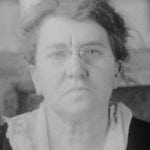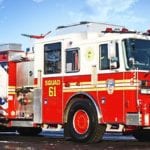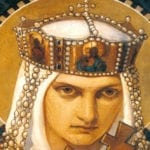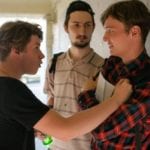 Technology
Technology  Technology
Technology  Humans
Humans 10 Everyday Human Behaviors That Are Actually Survival Instincts
 Animals
Animals 10 Animals That Humiliated and Harmed Historical Leaders
 History
History 10 Most Influential Protests in Modern History
 Creepy
Creepy 10 More Representations of Death from Myth, Legend, and Folktale
 Technology
Technology 10 Scientific Breakthroughs of 2025 That’ll Change Everything
 Our World
Our World 10 Ways Icelandic Culture Makes Other Countries Look Boring
 Misconceptions
Misconceptions 10 Common Misconceptions About the Victorian Era
 Mysteries
Mysteries 10 Strange Unexplained Mysteries of 2025
 Miscellaneous
Miscellaneous 10 of History’s Most Bell-Ringing Finishing Moves
 Technology
Technology Top 10 Everyday Tech Buzzwords That Hide a Darker Past
 Humans
Humans 10 Everyday Human Behaviors That Are Actually Survival Instincts
 Animals
Animals 10 Animals That Humiliated and Harmed Historical Leaders
Who's Behind Listverse?

Jamie Frater
Head Editor
Jamie founded Listverse due to an insatiable desire to share fascinating, obscure, and bizarre facts. He has been a guest speaker on numerous national radio and television stations and is a five time published author.
More About Us History
History 10 Most Influential Protests in Modern History
 Creepy
Creepy 10 More Representations of Death from Myth, Legend, and Folktale
 Technology
Technology 10 Scientific Breakthroughs of 2025 That’ll Change Everything
 Our World
Our World 10 Ways Icelandic Culture Makes Other Countries Look Boring
 Misconceptions
Misconceptions 10 Common Misconceptions About the Victorian Era
 Mysteries
Mysteries 10 Strange Unexplained Mysteries of 2025
 Miscellaneous
Miscellaneous 10 of History’s Most Bell-Ringing Finishing Moves
10 Acts Of Anarchist Terrorism That Shocked The World
The Industrial Revolution and the rise of capitalism transformed the social structures of civilized society. The gap between the classes became a yawning chasm, and the poor regarded the government and their bosses as tyrants. Many turned to a philosophy called Anarchism, from the Greek meaning “no ruler.” Anarchism despised all authority and taught that humans can live in a society free from restrictive laws. One of its fathers, Pierre Proudhon, famously said: “What is property? Property is theft!”
Proudhon himself did not advocate violence, and few anarchists were bomb-throwers. But desperate individuals heard the propaganda and took it upon themselves to strike against entrenched privilege.
10The Haymarket Riot

On May 3, 1886, police and strikers clashed outside Chicago’s McCormick Reaper Works, leaving two strikers dead. The following evening, 2,000–3,000 laborers protested in Chicago’s Haymarket Square, led by August Spies, editor of the Anarchist daily Die Arbeiter-Zeitung. “A pound of dynamite is better than a bushel of bullets,” Spies had cried. “Police and militia, the bloodhounds of capitalism, are ready to murder!”
Police took no chances and deployed a force of 175 officers. As the night wore on, the ranks of demonstrators thinned due to rain, and as the last speaker finished up, it looked like the affair would end peaceably. Then when the crowd started to disperse, someone threw dynamite into the ranks of police. The explosion killed Officer Matthias Degan and wounded seven more cops. Terrified police shot blindly into the crowd and wounded several, including Spies’s brother Henry. Four workers died.
No one knew who threw the bomb. But in a wave of xenophobia, police rounded up hundreds of foreign-born radicals and labor leaders. A grand jury indicted 31 of them, and eight were convicted and sentenced to death—including Spies.
“Let the world know,” cried Spies, “that in 1886, in the state of Illinois, eight men were sentenced to death because they believed in a better future!” On November 11, 1887, Spies and three others were executed. His final words would inspire unionists and anarchists: “The day will come when our silence will be more powerful than the voices you are throttling today.”
Questions about the guilt of the “Haymarket Eight” persisted, however, and Illinois governor John P. Altgeld granted full pardon to the three of them still alive in 1893.
9Berkman Shoots Frick

In 1892, steel magnate Andrew Carnegie slashed workers’ wages in response to a fall in steel prices. While he vacationed in Scotland, he instructed the general manager of his plant, Henry C. Frick, to deal with the Amalgamated Association of Iron and Steel Workers. The ensuing clash between Frick and 3,000 striking workers resulted in a bloody battle in which three Pinkerton detectives and nine workers died. State militia armed with Gatling guns took over the plant.
The uncompromising and heartless Frick became the focus of anarchist Alexander Berkman’s rage. His girlfriend and fellow anarchist Emma Goldman wrote: “A blow aimed at Frick would re-echo in the poorest hovel, would call the attention of the whole world to the real cause behind the Homestead struggle. It would also strike terror in the enemy’s ranks and make them realize that the proletariat of America had its avengers.”
Berkman gained access to the building where Frick had his offices. Frick was conferring with his partner John Leishman when Berkman burst through the door and shot him. Two bullets hit Frick in the neck before Leishman grappled with Berkman and a third shot went wild. A bleeding Frick tried to assist his partner, but Berkman had a dagger in reserve. He stabbed Frick four times. But the pair finally managed to subdue Berkman, and Frick miraculously survived his wounds.
Berkman proudly boasted that he had committed “the first terrorist act in America.” He served 14 years in prison before being pardoned in 1906. He and Emma were expelled from the country in 1919. Asked to comment on Frick’s death shortly before their departure, Berkman said that Frick had been “deported by God. I’m glad he left the country before me.”
8Slaughter At The Opera

The most deadly anarchist terror assault—72 dead or seriously injured—happened in Barcelona in 1893, at the Liceu opera house.
The opera season opened on November 8, three days before the anniversary of Spies’s and his accomplices’ execution. Barcelona’s elite came to see a performance of Rossini’s William Tell, a tale of the downtrodden rebelling against society’s tyrants. During the second act, two bombs were thrown from the gallery. One struck the back of a patron, and its fuse went out. But the other’s force ripped through human bodies, tore up the floor, and shattered the beams above. Pandemonium ensued, people trampling one another as they fought for the exits. Men abandoned the ladies they had escorted in the mad, terrified scramble. The wounded staggered outside, dresses torn, blood staining starched shirt fronts.
Queen-regent Christina declared a state of emergency and suspended the city’s constitutional liberties. Hundreds of suspects were thrown into the dungeons of Montjuich castle, where merciless torture produced the name “Santiago Salvador” as the terrorist of Teatro Liceu.
Salvador was arrested in January 1894 and confessed, calling the bombing an act of revenge for the execution of a fellow anarchist named Pallas. Salvador reportedly said, “I conceived of a plan in which it was possible to terrorize those who had enjoyed killing him and who believed that they had nothing to fear.” The opera house was an ideal target because it was exclusively attended by the rich, who had always mocked him and his fellow workers.
Unable to believe that Salvador had acted alone, authorities continued the Inquisition-like tortures that eventually forced six more prisoners to confess. All were executed in April, and Salvador was sent to his death in November.
7Attack On The French Parliament

As a youth, Auguste Vaillant spent time in jail for stealing food. Hounded by poverty, he moved to Argentina with his mistress and daughter to find opportunities but was forced to return to France. Vaillant wandered the streets of Paris a hungry vagabond, unable to feed his family. In despair, he decided to end his misery, not in anonymous silence but with a gesture that would symbolize the “cry of a whole class.” The target would be the source of all of society’s inequalities: the scandal-tainted Parliament.
Vaillant filled a saucepan with nails and a small charge of explosive—a deliberately small bomb, since his wanted to make a statement, not kill anyone. On the afternoon of December 9, 1893, Vaillant entered the Chamber of Deputies with the device. He threw it where the deputies were engaged in debate, spraying them with the shrapnel and slightly injuring 20. Vaillant escaped in the chaos but gave himself up the next morning.
Though no one died, the attack frightened and enraged the lawmakers. They immediately made it a crime to print any provocation that would lead to a terrorist act. Anarchist newspapers were shut down, and hundreds of warrants were issued. But Vaillant had succeeded in getting the attention of all of France.
Many non-Anarchists of the far right—the anti-republican royalists and aristocrats—even expressed sympathy. The poet Laurent Tailhade said, “What do the victims matter if it’s a fine gesture?” In a twist of fate, Tailhade would lose an eye in a later terror bombing.
Vaillant went to the guillotine on February 5, 1894. His last words were, “Death to the bourgeoisie society! Long live Anarchy!”
6The Cafe Terminus Bombing

The bombing of a Parisian cafe in February 12, 1894 ignited the age of modern terrorism, and its perpetrator, an intellectual named Emile Henry, fits the description of a “terrorist” as we define it today. Before this, Anarchists had largely targeted authority figures—policemen, military, government officials. Henry chose as his victims ordinary people simply going about their daily lives.
Seeking to avenge the death of Vaillant, Henry hid a bomb in a metal lunchbox as he stalked the elegant cafes along the Avenue de l’Opera. He decided on the Cafe Terminus, ordered a beer and a cigar, and lit his bomb. The ensuing carnage killed one and injured 20. Henry was wrestled to the ground as he tried to escape.
Henry had acted on his belief that “there are no innocent bourgeois.” He had intended to kill more.
At his trial in April 1894, which ended with him sentenced to death, Henry did not hide his guilt. He rather used the court as a forum for Anarchist propaganda. He ranted, “We who hand out death know how to take it . . . (Anarchism) is in violent revolt against the established order. It will finish by killing you.”
5The Assassination Of President Carnot

Hardly had the French public recovered from the Emile Henry affair when the next Anarchist blow struck in the city of Lyons on June 24, 1894. French President Sadi Carnot was in town for an exhibition, and an enthusiastic crowd greeted him. Carnot was anxious to see and be seen by the exuberant throng and asked that the carriage be left open and accessible. That sealed his doom.
A 21-year-old Italian Anarchist, Cesare Giovanni Santo, approached the carriage carrying a rolled-up newspaper. Thinking Santo held a petition for the President, the bodyguards allowed him to approach the carriage step. Santo sprang up. With a dagger concealed by the newspaper, he stabbed Carnot deep in the abdomen, crying, “Long live the Revolution! Long live Anarchy!”
The President sank back into the cushions, and Santo was seized as he jumped down from the step. Police had to surround him to keep the crowd from lynching him. Carnot was rushed to the Prefecture, where he died at 12:45 A.M. As soon as the assassin’s nationality was known, backlash began. An Italian restaurant was sacked the same night, and police had to surround the Italian Consulate to protect it from mob fury.
The assassination marked a watershed in the 19th century’s version of the War on Terror. Italy, to salvage its tarnished reputation, proposed worldwide cooperation against Anarchism. In the International Anti-Anarchist Conference in Rome on November 24, 1898, 21 participating states rejected Anarchism as a legitimate political philosophy.
Unlike his comrades, Santo shrank and trembled before the guillotine on the day of execution. He had to be dragged by the executioner’s assistants, crying “I won’t go! I won’t go!”
4The Corpus Christi Attack

Late 19th- and early 20th-century Barcelona could well rival 21st-century Baghdad in terms of bomb attacks—it even earned the nickname “City of Bombs.” One of the more horrific incidents, and the most politically consequential, was the tragedy of June 7, 1896, Corpus Christi Day.
The traditional procession of the Sacred Host led by the bishop, the Captain-General, and other dignitaries was on its way to Santa Maria del Mar when a bomb dropped from a top-story window. Instead of hitting the church and government authorities as intended, it killed seven working class citizens and a soldier. The bomber was never identified.
Unfortunately for Barcelona, its Captain-General was the ruthless Valeriano Weyler, who immediately unleashed the newly formed police force Brigada Social upon the usual suspects. Mass arrests of Anarchists and anti-clericals swept the city, and the prisoners were once again thrown into Montjuich and tortured. Deaths from the abuse and executions mounted.
An Italian anarchist named Michel Angiolillo decided enough was enough. He traveled to Santa Agueda, where Spanish Prime Minister Antonio Canovas del Castillo was relaxing at the spa. Angiolillo fired three shots at point-blank range. Canovas died with the words “Long live Spain” on his lips.
The Liberals who took over succeeded in reining in General Weyler just as he was on the brink of quelling the revolt in Cuba. With his dismissal, the war flared up again, giving imperialists in the United States the excuse to intervene. Had Canovas lived, there might not have been a Spanish-American War, and the history of Cuba, Puerto Rico, and the Philippines would have been vastly different.
3The Assassination Of President McKinley
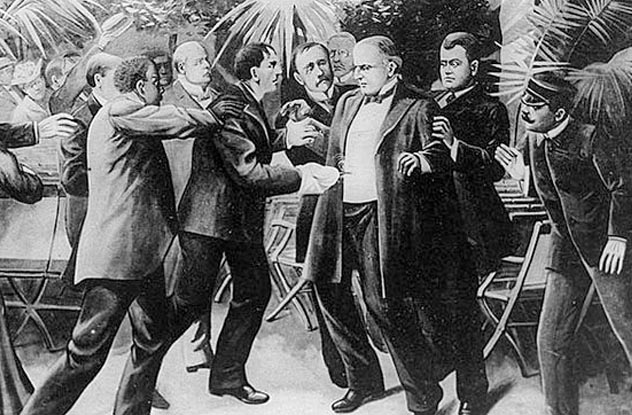
Leon Czolgosz, son of Polish-Russian immigrants, was enamored with Anarchist doctrine. In 1900, his excitement rose when Italy’s King Umberto was murdered by the Anarchist Gaetano Bresci. Czolgosz began attending speeches by the revolutionary Emma Goldman, who spoke of class struggle and said it was time to take action against the government. Czolgosz decided he would be the one to do the deed.
On September 6, 1901, Czolgosz stood in line at the Pan-American Exposition in Buffalo, New York to shake hands with President William McKinley. The President’s secretary had been worrying about his security and advised McKinley it wasn’t worth the risk to greet a small number of people. “Who would want to hurt me?” McKinley asked, rather naively.
As Czolgosz approached the President, Secret Service agent George Foster stood 150 centimeters (5 ft) away. He saw nothing unusual as Czolgosz stepped up to McKinley with a handkerchief in his hand—the hot weather had many guests using handkerchiefs to wipe off sweat. But Czolgosz’s hanky hid a gun, and he pumped two bullets into McKinley’s chest.
The President staggered, bloodied, and was helped into a nearby chair. “Be careful how you tell my wife,” he pleaded weakly. Foster tackled the assassin as he prepared for a third shot. “Don’t let them hurt him,” McKinley said. He underwent surgery at a nearby hospital, and he seemed to be recovering when gangrene set in. He died on September 14.
Czolgosz readily owned up to his crime. “I killed President McKinley because I done my duty,” he explained without emotion. “I didn’t believe one man should have so much service and another man should have none.” He was electrocuted on October 29. Prison guards doused his body with sulfuric acid to render it unrecognizable.
After McKinley’s murder, Congress directed the Secret Service to make the protection of the President its primary and permanent duty.
2The Murderous Wedding Crasher
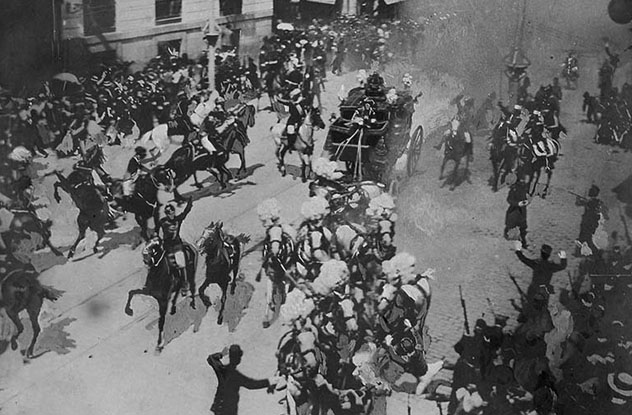
May 31, 1906 was supposed to be a fairy tale day for Spanish King Alfonso XIII and his bride Victoria Eugenie “Ena” of Battenberg. It was the day they were married amid magnificent pomp at the Royal Monastery of San Jeronimo el Real in Madrid. But when the newlyweds were on their way back to the palace, a bomb flew at them.
A medal on Alfonso’s chest blocked the shrapnel. Blood from an injured guard splattered Ena’s dress, but she miraculously escaped unharmed as well. About 25 people died in the blast, and around 130 were injured, making this the bloodiest Anarchist attack up to that point.
The terrorist was later identified as Mateo Morral, who may also have been responsible for a similar attack on King Alfonso a year before. Morral had planned to detonate the bomb during the wedding ceremony itself but couldn’t enter the church. Had he been able to do so, he would have blown up half of Europe’s royalty in attendance.
1The Galleanists Bombings

On the night of June 2, 1919, in nearly simultaneous attacks, bombs rocked New York, Boston, Pittsburgh, Cleveland, Patterson in New Jersey, Washington D.C., and Philadelphia. The intended targets included a mayor, a state legislator, three judges, two businessmen, a cop, and a Catholic priest.
The most prominent target was US Attorney General Mitchell Palmer, who had just gone upstairs at about 11:15 PM when a powerful explosion destroyed the downstairs of his home. Palmer and his family escaped unhurt, but the blast was so strong it shattered the windows of the nearby home of Franklin D. Roosevelt, the Assistant Secretary of the Navy. The future president hurried over to the scene of the bombing and discovered the body of a dead Anarchist, later identified as Carlo Valdinoci. His device had gone off prematurely, killing him. As with the rest of the bombs, none hurt their intended victims though two other people died. But the nature of the attacks traumatized the American public.
In this atmosphere of terrorism and labor conflicts arose the 1919 Red Scare. It didn’t assuage public paranoia that Russia had just turned Bolshevik two years earlier. Leftist propaganda unleashed on the people was bloodcurdling: “There will have to be bloodshed . . . there will have to be murder . . . we will destroy to rid the world of your tyrannical institutions.”
The Department of Justice contributed to the panic by propagating the myth that the bombings were part of a vast conspiracy to topple the US Government. Attorney General Palmer took charge of the subsequent raids, arrests, and deportations of numerous anarchists, socialists, and communists. Gross violations of civil liberties, though, led to strong backlash against Palmer. Palmer predicted May 1, 1920 as the start of the revolution. When the day passed without incident, Palmer was discredited and fell from power.
+The Bombing Of Wall Street

At noon on September 16, 1920, a wagon pulled up in front of the Wall Street offices of J.P. Morgan & Co., the most powerful banking firm in the world. Its infernal cargo consisted of dynamite with window sash weights for shrapnel. The driver fled, and seconds later, a powerful explosion ripped through lower Manhattan.
Windows shattered. People were lifted from the street, including a young stockbroker named Joseph P. Kennedy. In an eerie foreshadowing of a future attack 81 years later in the same area, World War I veterans thought the bombs came from planes roaring through the skies. A mushroom-shaped yellow-green cloud of smoke and flame rose 30 meters (100 ft) over America’s busiest financial district. Ashen-faced people fled from the chaos that eventually killed 39 and injured hundreds more—the deadliest terrorist attack on American soil until the Oklahoma City bombing in 1995.
The bomb missed J.P. Morgan the man, who was on vacation, but wounded his son Junius and killed his chief clerk at his desk. The rest of the dead were unfortunate souls caught in the wrong place at the wrong time—ordinary messengers, clerks, stenographers, and brokers. A woman’s severed head was discovered stuck to the concrete wall of a building, with the hat still on. Mutilated bodies littered the ground. One victim, burned and half-naked, tried to rise and toppled back dead in the gutter.
No one claimed responsibility for the attack, and no one would be brought to answer for the atrocity. But the finger of suspicion turned to Anarchists, who had been harassing the Morgans with letter bombs. A message was found in a nearby mailbox which read: “Free the political prisoners. Or it will be sure death for all of you. American Anarchist Fighters.” It perhaps referred to anarchists Sacco and Vanzetti, indicted the day before for robbery and murder.
Among the suspects taken in for questioning were well-known Anarchist Carlo Tresca and eccentric tennis champion Edward Fischer. Fischer had allegedly predicted the bombing to his friends, but he turned out to be simply mentally unhinged and was sent to Bellevue Hospital.
